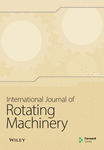Experimental Investigation of Cavitation Signatures in an Automotive Torque Converter Using a Microwave Telemetry Technique
Abstract
A unique experimental investigation of cavitation signatures in an automotive torque converter under stall conditions is reported. A quantitative criterion is proposed for predicting early and advanced cavitation in terms of suitable nondimensional pump speeds. The dimensionless pump speed that marks early cavitation is obtained by relating this parameter to the appearance of charge-pressure–dependent pressure fluctuations in the differential pressure transducer readings. The differential pressure transducers were mounted at well-defined locations in the pump passage of a torque converter. The data were transmitted by a wireless telemetry system mounted on the pump housing. Data were received and processed by a ground-based data acquisition system. Automatic transmission fluid exhibited cavitation for charge pressures of 70–130 psi and pump speeds of 1000– 2250 rpm. Advanced cavitation was marked by operating conditions that exhibited a 2% or more torque degradation from the converter′s noncavitating performance.
For a given family of torque-converter designs and a given transmission fluid, the proposed nondimensional pumpspeed criteria are capable of marking early and advanced stages of cavitation for a range of torque-converter sizes and a range of charge pressures in the torque converter.




